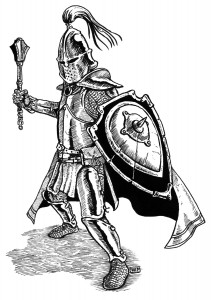It’s game night — snacks are laid out, drinks are in the fridge, the minis are selected, the dungeon map is ready and you’re rearing to go. There’s just one problem — life happens and only one player shows up.

A moment of awkward silence occurs as you mentally flip through your collection of movies while the player tries to figure out how to extricate himself from the situation. However, not all is lost; you could run a solo adventure!
Sometimes it happens, you’re ready for the game but everyone bails for whatever reason except one, faithful player. Or, maybe, you got a player itching to break out from the group and take the limelight for himself for whatever reason. However it happens, you are faced with the daunting task of a solo adventure. Why is it daunting?
- Just one player? So easy for him to die!
- If he does live, I’m not giving out that much XP to one person!
- I don’t even know what kind of adventure to run.
I’ve had some of the most fun in RPGs running solo adventures. One-on-one with a player allows you both to dig deep into the character and the story elements that you sometimes miss with a normal sized party. When running a solo adventure, you need to talk with the player and set clear expectations of what he wants to accomplish with the adventure. This allows you to do a great many, fun things:
- Gain a Level: If the player is behind the group because he missed a couple sessions this is a great opportunity for him to earn some XP. Alternatively, you can let him hit the minimum requirement for next level.
- Magic item: Maybe your player craves a certain magic item. Turn it into an idea for a story. Let him quest for it; instead of XP, he gets the magic item.
- NPCs: Solo quests are great ways to introduce new NPCs or let a player pursue/develop a relationship (ally, love interest, mentor etc.) with an NPC. Grant the player a reward or boon for helping the NPC complete a quest or deal with a problem instead of XP.
Solo quests can be dangerous, particularly if they feature lots of combat, so it’s important to anticipate problems:
- Weaker Monsters: Don’t use the same monsters you would throw at the entire party. Monsters a few tiers down from your player can provide an appropriate challenge. Be very careful including monsters that have a power – for example the ghoul’s paralysing touch – that can end the combat with one unlucky die roll.
- NPC helpers: NPCs that benefit from your player succeeding at the quest offer to help (especially if the NPC has healing resources). This is a great way to introduce or develop pre-existing NPC relationships.
- Use Noncombat Encounters: Not everything needs to be resolved with bloodshed. Create encounters that play to the player’s noncombat strengths.
Solo adventures don’t have to end in player death. Instead, embrace them as a chance to let the player shine and engage in activities he couldn’t do in the larger group.
Help Fellow GMs!
Have you got any hints or tips for running solo adventures? Share them below and help your fellow GMs run better solo adventures.
Coolio.
Thank you to John Bennett for writing this article. It’s much appreciated, John!
Some great advice here. Any advice for solo-campaigns? Thoughts on letting the player use two characters?
The solo campaign I’ve been running has been greatly enhanced, in a number of ways, simply by adding some very detail-oriented NPC’s that fall somewhere between a sidekick type to an equal and complimentary partner in adventuring. Say the PC is a wizard or a cleric, make a fighter or paladin to be the muscle. Or if its a rogue, maybe make a partner in crime like a bard or wizard. The focus should be on the PC and the NPC should fully reflect that. Then there seems to be an endless amount of interesting hooks that will present themselves.
This was the only way to play back in the 80’s as a kid. No internet + too young to drive= you and your brother taking turns DM’ing and running multiple characters, or doing solo adventures.
really would like more ideas about 1 0n 1 adventures. I’m introducing my Son to Ad&d and would love help & ideas. Im doing 1str & 2nd ,but also have access to 5th.